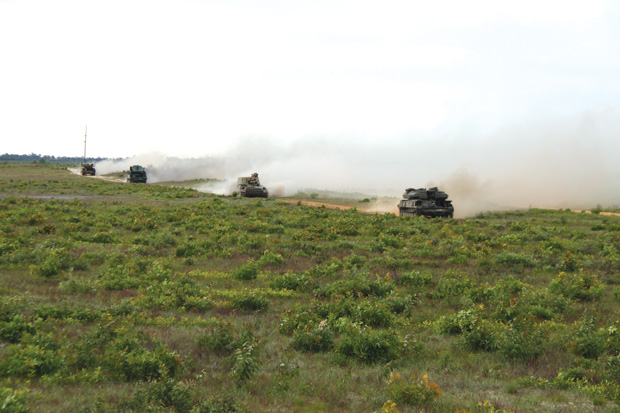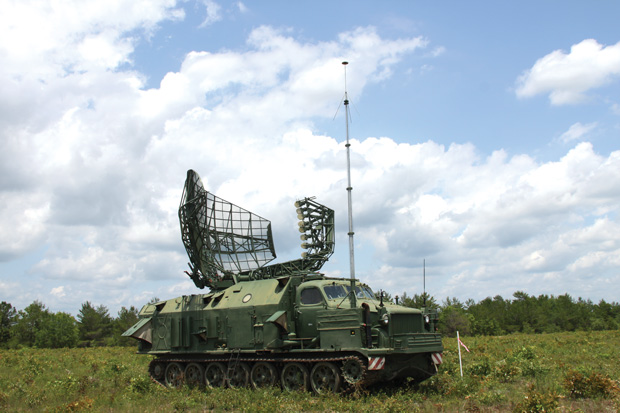
A Height Finding Radar was used for seeker/sensor testing during Sensor Week at Eglin Air Force Base this year. Image courtesy of USAF.
August 1, 2016
Testing defense and military systems can pose a significant challenge. These systems have to perform under battlefield conditions that are harsh and unpredictable. Because you can’t test in an actual operating theater, simulating field conditions is the next best scenario. However, it can be difficult and expensive if you need to test a sensor solution that requires the participation of a fighter jet or a convoy of tanks and trucks.
From May 16 to 27, more than 50 U.S. Department of Defense (DoD) organizations and private companies arrived at Eglin Air Force Base near Valparaiso, FL, for an event that marries product testing, research and battle simulations: Sensor Week. Participants were able to test new sensor and seeker technology on a testing range with more than 400 vehicles and aircraft, including everything from Air Force jets to Russian fuel trucks and missile launchers.
 An SA-6 Transporter Erector Launcher (TEL) was used for seeker/sensor testing during Sensor Week at Eglin Air Force Base this year. Image courtesy of USAF.
An SA-6 Transporter Erector Launcher (TEL) was used for seeker/sensor testing during Sensor Week at Eglin Air Force Base this year. Image courtesy of USAF.During the event a host of different sensor-based solutions are tested using actual Air Force planes and military ground vehicles and equipment so that manufacturers and system designers can capture data that would otherwise be expensive and difficult to gather. They can then share that data with other participants and with the DoD.
“Customers come to Sensor Week to measure seeker/sensor data using their equipment on various scenarios such as ground threat vehicles or improvised explosive device scenarios,” says 1st Lt. Keegan George at Eglin. “They usually have a new system or new software for seekers and sensors. We also have some more operational guys who were doing tactics development. Without going into too much detail, there are radar systems on the range and we can fly against those and see how the aircraft perform, when the radar can see them, and how the different ways they can fly will affect that.”
Sensor Week is hosted every two years by Project Chicken Little as part of the 46th Test Squadron’s Sensor and Defensive Systems Test Flight. The event is sponsored by the Air Combat Command (ACC), and costs are shared between the government and participants – a key feature of the event because having each organization or company conduct such testing individually would be prohibitively expensive and present logistics challenges.
Eglin also hosts the complementary event, Acoustics Week, which is held in odd-numbered years. That event focuses on acoustic sensors with more of a focus on ground testing for moving vehicles.
Cost-Effective Testing
Cost sharing is one of the primary benefits of the joint event. “We have 400 vehicles out for Sensor Week,” George says. “To get all of those out and get the data would cost one system more than $1 million just for one test. This spreads out the cost. Chicken Little provides the scenario development, ground truth data, and test engineers and analysts. All the customer has to do is show up with the sensor suite and the test team to operate it, and a platform to fly it on.”
The event helps reduce risk for the Air Force Materiel Command, and provides a significant return on investment in testing funds because so much data generated at one time.
Participants this year included a variety of DoD organizations including the Air Force Research Laboratory and the Army Research Laboratory, along with MIT, Lockheed Martin, Northrop Grumman and a host of other private companies.
 An convoy of vehicles being tested during Sensor Week. From front to rear: ZSU23-4, 2S3, SA-6 Radar, SA-6 TEL. Image courtesy of USAF.
An convoy of vehicles being tested during Sensor Week. From front to rear: ZSU23-4, 2S3, SA-6 Radar, SA-6 TEL. Image courtesy of USAF.Participants tested a number of electro-optical/infrared (EOIR) sensors, visual sensors, infrared systems, airborne radar and other technologies. They test their sensor systems for a variety of scenarios, including radar detection, aircraft detection and ground threat vehicle and improvised explosive device scenarios.
“The organizations are looking at trucks, tanks and radar systems on the range and trying to correctly identify them,” George says. “The main objective is identifying different vehicles and making sure they can tell the difference between a tank that’s a threat, for example, and a school bus.”
The Eglin range is broken into different sections with a variety of static arrays (including boats, trucks, tanks and radar systems), along with moving assets like convoys of vehicles and radars that are actively emitting. “The sections are broken up into things that might be grouped together in an operational environment,” George says. “We also had 15 types of aircraft flying as well.”
Data Sharing
Many defense systems have benefited from the Sensor Week data over the years, including the Hellfire missile and the AGM-88E Advanced Anti-Radiation Guided Missile (AARGM), an Air Force manned reconnaissance platform.
The types of sensors tested are typically used on aircraft and for tracking foreign and domestic ground assets, vehicles, bombs, and for defensive purposes. The data generated during these tests winds up being used across the services. “The data isn’t specific to one platform or one system, but gets used by the Navy, Coast Guard, Air Force and Army,” says George.
One unusual test this year was an airbase recovery operation. “That customer simulated damage to a runway, and they were interested in collecting data to see if they could estimate how extensive the damage was,” George says. “They didn’t have a platform to collect on, so they set up the array and got buy-in from other customers to collect the data. It was a collaborative effort.”
At the end of the event, data is shared with the Eglin Signature Data Center. Project Chicken Little also provides ground truth reports to participants that include data points, photos, vehicle parameters and other information that help stakeholders evaluate and analyze the data.
 Testing with a Long Track Radar at Sensor Week lets participants gauge readiness against threats. Image courtesy of USAF.
Testing with a Long Track Radar at Sensor Week lets participants gauge readiness against threats. Image courtesy of USAF.The compiled data is available to any user within the DoD, and can be used to improve sensor systems.
George says the database includes several terabytes of data going back several decades. The information is categorized by the type of asset on the range; for example, all of the truck data would be grouped together. “If an organization or a Department of Defense contractor requests that data, we can send it out to them o they can come here and access it,” George says.
For the DoD, the data provides a wealth of information that can be used in multiple different projects and systems. “The data can be applied to algorithm development for seeker tracking or different identification software applications that are far reaching to all corners of the DoD,” George says.
More Info
Subscribe to our FREE magazine, FREE email newsletters or both!
About the Author
Brian Albright is the editorial director of Digital Engineering. Contact him at [email protected].
Follow DE




